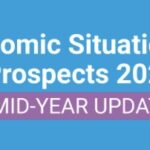S&P Global Ratings has upgraded Pakistan’s long-term sovereign credit rating to ‘B-‘ from ‘CCC+’, on July 24, 2025, citing improved external liquidity and fiscal consolidation supported by international aid and IMF-backed reforms, in a move that underscores the country’s tentative economic recovery after years of crisis.
The outlook is stable, reflecting expectations that Pakistan will continue to receive robust external support from key multilateral and bilateral partners while sustaining fiscal improvements to meet its heavy debt obligations.
The upgrade, marks the first time since 2021 that S&P has raised Pakistan’s rating, signaling reduced near-term default risks. Pakistan’s short-term rating was also raised to ‘B’ from ‘C’, and the transfer and convertibility assessment to ‘B-‘ from ‘CCC+’.
External buffers rebuilt
The ratings boost comes after Pakistan replenished its foreign exchange reserves to $20.5 billion as of July 4, 2025, up from a multi-year low of $6.7 billion in December 2022. The reserves, bolstered by inflows from an IMF Extended Fund Facility (EFF) of $7 billion approved in September 2024 and support from countries such as China, Saudi Arabia, the UAE and Kuwait, are sufficient to cover external payments of $13.4 billion due in fiscal 2026.
Pakistan’s current account swung into a surplus of 0.5 percent of GDP in fiscal 2025, the first in 14 years, aided by record remittances of $39 billion – nearly 9.5 percent of GDP – and tighter import controls.
“Pakistan is now less reliant on favorable macroeconomic developments to meet its obligations,” S&P said, warning, however, that the country still faces high gross external financing needs and elevated external debt ratios.
Fiscal reform gains but challenges remain
IMF-mandated tax reforms and spending controls have lifted government revenues by 3 percentage points of GDP in the past 12 months, allowing the fiscal deficit to narrow to 5.6 percent of GDP in fiscal 2025 from 7.9 percent in fiscal 2022. S&P expects the deficit to decline to 5.1 percent in fiscal 2026, though still above the government’s 3.9 percent target.
Inflation, which peaked at 29 percent in fiscal 2023, eased sharply to 4.5 percent in fiscal 2025. S&P projects average consumer price growth at 6.5 percent over the next two to three years, enabling the State Bank of Pakistan (SBP) to slash policy rates by 1,100 basis points since mid-2024 to 11 percent. This has cut interest costs, though debt servicing remains steep, with interest payments consuming 41 percent of government revenues – among the highest globally.
Pakistan’s net government debt, currently above 60 percent of GDP, is expected to decline gradually as fiscal consolidation progresses. Yet S&P flagged the country’s reliance on short-term external borrowing, saying continued rollovers of bilateral and commercial credit will be crucial.
Political risks and economic outlook
The upgrade comes despite persistent political uncertainty. The coalition government led by the Pakistan Muslim League-Nawaz (PML-N) has so far navigated IMF reforms without major social unrest, but public resistance to austerity and higher taxes remains a risk. Pakistan’s fractious political environment has been volatile since the ouster of former Prime Minister Imran Khan in 2022.
S&P projects Pakistan’s economy will grow 3.6 percent in fiscal 2026, following 2.7 percent in fiscal 2025. While industrial and services sectors are rebounding, agriculture remains subdued due to weak crop yields and adverse weather. GDP per capita, stuck near $1,600 due to rupee depreciation in recent years, is expected to rise modestly above $2,000 by fiscal 2027.
“Stability in the rupee, easing inflation, and IMF-driven reforms are restoring confidence,” said an economist at a Karachi-based investment bank. “But the country’s recovery remains fragile, hinging on sustained external support.”
Risks and scenarios
S&P warned it could downgrade Pakistan if foreign reserves decline sharply, or if external financing from multilateral and bilateral partners falters, leading to difficulties in servicing external debt. Conversely, the rating could rise if Pakistan delivers steady economic reforms, fiscal consolidation, and growth that outperform expectations.
The country remains vulnerable to external shocks and security risks. Border tensions with India resurfaced after the Pahalgam terrorist attack in May 2025, raising concerns of potential military escalation that could derail economic stability.
Context: A fragile turnaround
The upgrade marks a reversal of fortunes from December 2022, when S&P cut Pakistan’s rating to ‘CCC+’ amid dwindling reserves and heightened default risks. Since then, the IMF’s EFF and a $1.4 billion Resilience and Sustainability Facility (RSF) have provided a financial lifeline, triggering renewed multilateral and bilateral aid. The World Bank’s $20 billion 10-year Country Partnership Framework, approved in January 2025, further signals donor confidence.
Still, S&P noted that Pakistan’s external debt remains high, with net external debt forecast to reach 128 percent of current account receipts by end-2025. “Pakistan’s sovereign credit profile has improved, but vulnerabilities remain acute,” S&P said.


![s&P ratings[2]](https://southasianherald.com/wp-content/uploads/2025/07/sP-ratings2.jpg)



